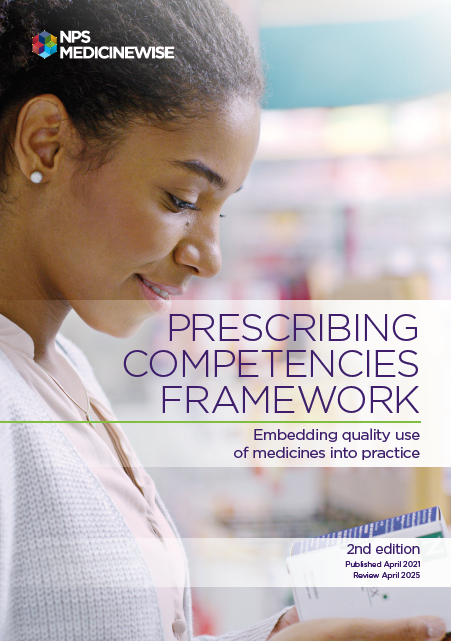Prescribing Competencies Framework
The Prescribing Competencies Framework describes the competencies that health professionals require to prescribe medicines judiciously, appropriately, safely and effectively in the Australian healthcare system

NPS MedicineWise recognises the ongoing need for, and value of, a consistent and standard approach to prescribing for all health professionals with prescribing rights.
Since the publication of the original framework in 2012, prescribing rights have been extended to new professional groups. This places an onus on a broader range of health professionals to contribute to quality use of medicines within their scope of practice. The need for, and value of, a consistent and standard approach to prescribing for all health professionals with prescribing rights is therefore ever more prevalent. Adequately preparing health professionals to prescribe within a quality use of medicines framework is essential.
As the national steward of Quality Use of Medicines, NPS MedicineWise, in consultation with key stakeholders in the sector, has undertaken a review of the original framework to ensure the document is contemporary, relevant and fit for purpose in order to continue to be of value in supporting quality prescribing decisions by all prescribers.
Intended Use of the Framework
The Framework describes prescribing expectations for all prescribers, regardless of profession, and can be viewed as a description of safe and effective prescribing. Prescribers should apply the competencies to their individual prescribing context, including their recognised scope of practice and the professional and legislative boundaries within which they prescribe. The Framework recognises that prescribers will engage in the four stages of prescribing (information gathering, clinical decision making, communication and monitoring/review)11 according to the person’s needs and within the expectations of their prescribing arrangement, which may include specific collaborative care arrangements or drug therapy protocols.
The Framework may contribute generally to a shared understanding of the prescribing process and more specifically to the following:
- The development of education and training programs The Framework provides important information for those responsible for curriculum design and may inform decisions about program content, assessment and expected outcomes, for programs that lead to health practitioner registration. Accreditation authorities are able to use the Framework to support the development of required accreditation standards relevant to programs of study that support prescribing practice.
- Continuing professional development The Framework provides structure to the development of formal professional development programs such as those provided by professional organisations. These programs may contribute to the demonstration of professional development required as part of professional regulation.
- Self-reflection The Framework may be used by individual prescribers to develop personal learning plans. Because it clearly describes expected competencies and provides examples of what the competencies may look like in practice, individuals are able to use the Framework in their own self-reflection and professional development. In addition, students may use the Framework to guide their acquisition of essential knowledge and skills in preparation for a prescribing role.
- Health professional regulation The Framework may be used by National Health Practitioner Boards to describe elements of practice that require demonstration in order to achieve or maintain registration as a prescriber.
- Recognition of the prescribing role By clearly describing the important aspects of prescribing, the Framework may contribute to a greater understanding of the role of the prescriber within the collaborative healthcare team.
Updates to the Framework
The Framework continues to reflect the Australian definition of prescribing by defining the competencies important to each stage of the prescribing process. Updates that have been made from the previous edition include:
- Revised structure The Framework structure is simplified. The competency areas, elements, performance criteria and evidence examples found in the previous edition have been simplified to a description of the competencies supported by guidelines for inclusion in practice. It is hoped this change will ensure the competencies are more clearly identified, improving the utility of the Framework for all prescribers.
- Focus on describing the essential prescribing competencies In order to focus on the competencies required to prescribe medicines safely and effectively, competencies that describe the expectations of professional practice in general have been removed. For most professions, the expectations of a registered practitioner will be defined in detail in professional practice standards or competencies. It is therefore inefficient to attempt to replicate these expectations for all professions in the Framework.
- A renewed focus on the person and the provision of person-centred care Where possible, competencies are described using language that considers the person first.
- Simplified language Competencies are described using plain language applicable to all professions. Concise descriptions of the competencies are supported by additional information and examples where appropriate. It is hoped this change will increase the utility of the Framework across all sectors.
